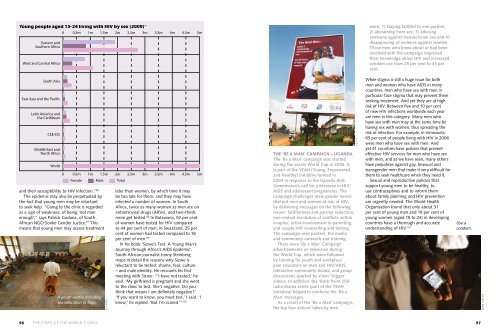Create successful ePaper yourself
Turn your PDF publications into a flip-book with our unique Google optimized e-Paper software.
Young people aged 15-24 living with HIV by sex (2009) 95<br />
Eastern and<br />
Southern Africa<br />
West and Central Africa<br />
0<br />
0.5m 1m 1.5m 2m 2.5m 3m 3.5m<br />
4m 4.5m<br />
5m<br />
were: 1) staying faithful to one partner,<br />
2) abstaining from sex, 3) advising<br />
someone against transactional sex and 4)<br />
disapproving of violence against women.<br />
Those men who knew about or had been<br />
involved with the c<strong>am</strong>paign improved<br />
their knowledge about HIV and increased<br />
condom use from 25 per cent to 45 per<br />
cent.<br />
South Asia<br />
East Asia and the Pacific<br />
Latin America and<br />
the Caribbean<br />
CEE/CIS<br />
Middle East and<br />
North Africa<br />
World<br />
0 0.5m 1m 1.5m 2m 2.5m 3m 3.5m 4m 4.5m 5m<br />
Female Male Total<br />
and their susceptibility to HIV infection.” 96<br />
The epidemic may also be perpetuated by<br />
the fact that young men may be reluctant<br />
to seek help. “Going to the clinic is regarded<br />
as a sign of weakness, of being ‘not man<br />
enough’,” says Patrick Godana, of South<br />
African NGO Sonke Gender Justice. 97 This<br />
means that young men may access treatment<br />
A youth centre providing<br />
sex education in Togo.<br />
A l f B e r g<br />
later than women, by which time it may<br />
be too late for them, and they may have<br />
infected a number of women. In South<br />
Africa, twice as many women as men are on<br />
antiretroviral drugs (ARVs), and two-thirds<br />
more get tested. 98 In Botswana, 52 per cent<br />
of women have tested for HIV compared<br />
to 44 per cent of men; in Swaziland, 25 per<br />
cent of women had tested compared to 18<br />
per cent of men. 99<br />
In his book ‘Sizwe’s Test: A Young Man’s<br />
Journey through Africa’s AIDS Epidemic’,<br />
South African journalist Jonny Steinberg<br />
maps in detail the reasons why Sizwe is<br />
reluctant to be tested: sh<strong>am</strong>e, fear, culture<br />
– and male identity. He recounts his first<br />
meeting with Sizwe: “‘I have not tested,’ he<br />
said. ‘My girlfriend is pregnant and she went<br />
to the clinic to test. She’s negative. Do you<br />
think that means I <strong>am</strong> definitely negative?’<br />
‘If you want to know, you must test,’ I said. ‘I<br />
know,’ he replied. ‘But I’m scared.’” 100<br />
The ‘Be a Man’ c<strong>am</strong>paign – Uganda<br />
The ‘Be a Man’ c<strong>am</strong>paign was started<br />
during the soccer World Cup in 2006. It<br />
is part of the YEAH (Young, Empowered<br />
and Healthy) initiative formed in<br />
2004 in response to the Uganda Aids<br />
Commission’s call for a decrease in HIV/<br />
AIDS and adolescent pregnancies. The<br />
c<strong>am</strong>paign challenges male gender norms<br />
that put men and women at risk of HIV,<br />
by delivering messages on the following<br />
issues: faithfulness and partner reduction;<br />
non-violent resolution of conflicts within<br />
couples; active involvement in parenting;<br />
and couple HIV counselling and testing.<br />
The c<strong>am</strong>paign uses posters, the media<br />
and community outreach and training.<br />
There were ‘Be a Man’ C<strong>am</strong>paign<br />
advertisements on television during<br />
the World Cup, which were followed<br />
by training for youth and workplace<br />
peer educators on men and HIV/AIDS,<br />
interactive community dr<strong>am</strong>a, and group<br />
discussions sparked by silent ‘trigger’<br />
videos. In addition, the ‘Rock Point 256’<br />
radio dr<strong>am</strong>a series (part of the YEAH<br />
initiative) helped to reinforce the ‘Be a<br />
Man’ messages.<br />
As a result of the ‘Be a Man’ c<strong>am</strong>paign,<br />
the top four actions taken by men<br />
Y . E . A . H .<br />
While stigma is still a huge issue for both<br />
men and women who have AIDS in many<br />
countries, men who have sex with men in<br />
particular face stigma that may prevent them<br />
seeking treatment. And yet they are at high<br />
risk of HIV. Between five and 10 per cent<br />
of new HIV infections worldwide each year<br />
are men in this category. Many men who<br />
have sex with men may at the s<strong>am</strong>e time be<br />
having sex with women, thus spreading the<br />
risk of infection. For ex<strong>am</strong>ple, in Venezuela,<br />
65 per cent of people living with HIV in 2006<br />
were men who have sex with men. And<br />
yet 41 countries have policies that prevent<br />
effective HIV services for men who have sex<br />
with men, and as we have seen, many others<br />
have prejudices against gay, bisexual and<br />
transgender men that make it very difficult for<br />
them to seek healthcare when they need it.<br />
Sexual and reproductive policies that<br />
support young men to be healthy, to<br />
use contraceptives and to inform them<br />
about f<strong>am</strong>ily planning and HIV prevention<br />
are urgently needed. The World Health<br />
Organisation found that only about 31<br />
per cent of young men and 19 per cent of<br />
young women (aged 15 to 24) in developing<br />
countries have a thorough and accurate<br />
understanding of HIV. 101<br />
Use a<br />
condom.<br />
A d a m H i n t o n<br />
96 the s tate of the world’s girls 97

















